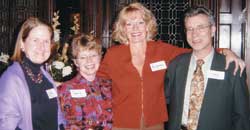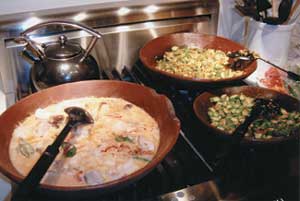




| Back to College: My Half-block Experience | |
| By Peggy Morgan Stenmark |
 |
| Jacqueline Lundquist (third from left) welcomes half-block student Kathy Brumder P ’99, ’05; Professor Marcia Dobson; and Professor John Riker to dinner at Stewart House. |
| photos by Judi Lakin |
I needn’t have worried — the workload was challenging, but not overwhelming.
On a chilly January morning, a dozen students (parents of current students and alumni of CC) filed into Hamlin House for our first day of Professor John Riker’s philosophy course, entitled “Ethics, Psychology, Society: Is It Good to Be Good?” Our discussions focused on the current state of American society.
One of the benefits of the Block Plan is the opportunity to immerse yourself in the subject. After that first morning, I could understand the attraction! As a group, we dived right in and explored the subject thoroughly, something hard to do in a typical college situation. It was invigorating and enlightening; I found myself eager for each day’s offering.
After a week of stretching our minds, Friday rolled around; talk of the dreaded paper surfaced. We met with our professor and classmates over a glass of wine… that definitely didn’t happen during my college years!
 |
| Professor Peter Blasenheim, displaying his culinary skills, treated his half-block class, “Understanding and Misunderstanding Latin America,” to a delightful Brazilian meal. Muqueca, chockfull of tuna, swordfish, shrimp, and scallops swimming in coconut milk and palm oil, simmers in a panelo de barro, an authentic African cooking vessel he hand-carried from South America. Side dishes included caruru and rice cooked in palm oil, with farinha de mandioca to sprinkle on top. |
Ideas in hand, I spent the weekend using Tutt Library’s excellent technology to research my topic; Monday morning, I ran my outline by Professor Riker. That night I came up with three pages, and after Tuesday’s class, I hit the computer again. Five pages… yahoo! Torrey said it wasn’t bad for someone who hasn’t written an academic paper in 28 years.
In our last class discussions, I realized that each paper had something interesting and unique to say. We had all run the gauntlet of academia and come out unscathed… but not unchanged. Our half-block experience changed the way we see the world, and we left with a new group of friends, a feeling of achievement, and a greater sense of self-confidence.
The Colorado College | 14 East Cache La Poudre Street | Colo Sprgs, CO | 80903 || 719-389-6000